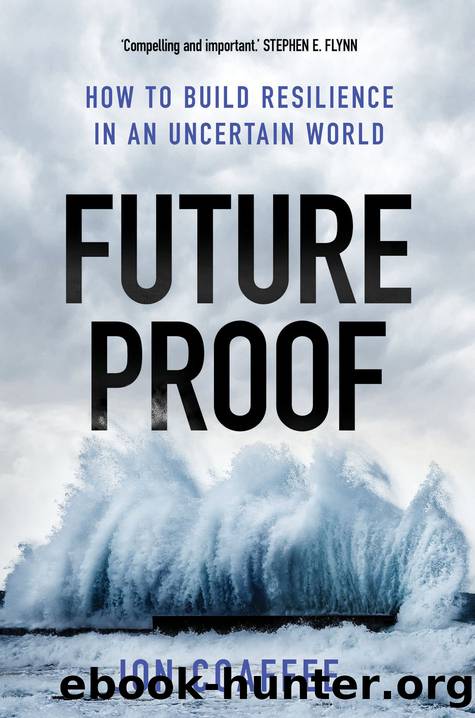Futureproof by Jon Coaffee;

Author:Jon Coaffee;
Language: eng
Format: epub
ISBN: 9780300228670
Publisher: Yale University Press
RESILIENCE AS CONTINUITY
After a crisis, disruption or disaster, it is not unusual to hear politicians and business leaders proclaim that in the short term we should seek ‘business as usual’. It is a phase that has been in common usage since the eighteenth century, when shops reopening after a fire or flood would put up a notice saying ‘Open for business as usual’. In popular parlance, the saying has often been attributed to famed British wartime leader Winston Churchill who, in 1914 as the then first lord of the Admiralty (a top position in the Royal Navy), used the phrase to refer to a government policy of non-interference in business affairs, given the expectation of a quick victory in the First World War. This use of the term was repurposed during the Second World War, when Churchill served as prime minister. It became a symbol of defiance and hope as bombed stores placed makeshift ‘Business as Usual’ signs outside their premises.
Over time, the idea of keeping the economy going at all costs when shocked and of promoting economic growth became central to both neoliberalism and early ideas of economic resilience. In this context, privatisation of the public sector, deregulation of the finance sector and lower corporate tax paid for by public spending cuts has paved the way for not only a perpetual state of inequality where the rich get richer and the poor stay poor,7 but also a situation where collective responses to crisis have become difficult to muster. Here, resilience has emerged either to frame such a collective stabilising response to disruption by the financial sector in combination with government assistance, or to illuminate how global markets and financial practices might be adapted to help deal with an uncertain future where disruption is anticipated.
Before the financial crisis, the concept and measurement of ‘economic resilience’ initially aligned with conventional resilience models that emphasised stability and equilibrium, and the extent to which they could resist disruption or ‘bounce back’ following external disturbance. Early work focused on the extent to which small nation states were able to survive and thrive in the face of fluctuating global economic conditions. Work by economist Lino Briguglio and colleagues at the University of Malta saw economic resilience as the ‘nurtured’ ability of an economy to recover from, or adjust to, the effects of adverse shocks to which it may be inherently exposed.8 Here such a ‘bounce-back’ framing referred to three different types of capabilities required to recover quickly from, withstand, or avoid shocks. Economic resilience was associated with shock counter-action such as policy tools that might counter-balance negative shock effects, for example through tax cuts. Another capability was the capacity to resist or withstand shocks and reduce or negate their effects – shock absorption. This might be seen to come through internal measures (what economists term endogenous) such as a flexible labour force and a diverse economy by which resources can be shifted between sectors. The ability of an economy to avoid shocks altogether is viewed as an inherent resilience trait and the opposite of economic vulnerability.
Download
This site does not store any files on its server. We only index and link to content provided by other sites. Please contact the content providers to delete copyright contents if any and email us, we'll remove relevant links or contents immediately.
Man-made Catastrophes and Risk Information Concealment by Dmitry Chernov & Didier Sornette(4728)
The Revenge of Geography: What the Map Tells Us About Coming Conflicts and the Battle Against Fate by Kaplan Robert D(3596)
Zero Waste Home by Bea Johnson(3285)
COSMOS by Carl Sagan(2944)
In a Sunburned Country by Bill Bryson(2941)
Good by S. Walden(2909)
The Fate of Rome: Climate, Disease, and the End of an Empire (The Princeton History of the Ancient World) by Kyle Harper(2429)
Camino Island by John Grisham(2379)
A Wilder Time by William E. Glassley(2358)
Organic Mushroom Farming and Mycoremediation by Tradd Cotter(2304)
Human Dynamics Research in Smart and Connected Communities by Shih-Lung Shaw & Daniel Sui(2173)
The Ogre by Doug Scott(2105)
Energy Myths and Realities by Vaclav Smil(2053)
The Traveler's Gift by Andy Andrews(2007)
Inside the Middle East by Avi Melamed(1937)
Birds of New Guinea by Pratt Thane K.; Beehler Bruce M.; Anderton John C(1904)
Ultimate Navigation Manual by Lyle Brotherton(1763)
A History of Warfare by John Keegan(1711)
And the Band Played On by Randy Shilts(1612)
